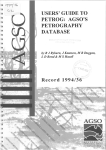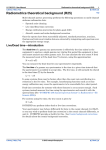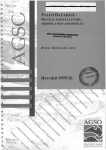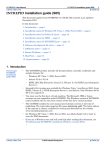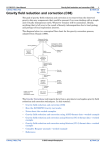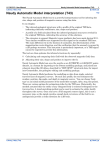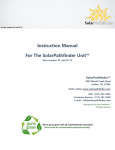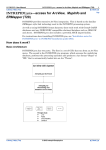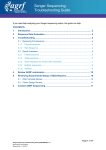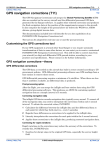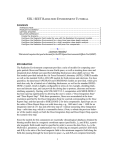Download The geomagnetic reference field in INTREPID (R15)
Transcript
INTREPID User Manual Library | Help | Top The geomagnetic reference field in INTREPID (R15) 1 | Back | The geomagnetic reference field in INTREPID (R15) Top The magnetic field of the Earth's core is a component of all raw magnetic data acquired during surveys. When processing magnetic data, it is beneficial to 'subtract' the influence of this component. The residual field data will then more clearly reflect the magnetic field of bodies in the Earth's crust. • We can correct for the intensity of the core field by estimating it and subtracting the estimate from our total magnetic intensity (TMI) data. • We can correct for anomaly displacements caused by the direction of the core field using a reduction to the pole correction. In each case we require an estimate of the core field. Geomagnetic Reference Field models INTREPID supports two Geomagnetic Reference Field (GRF) models to estimate the core field. • The International Geomagnetic Reference Field (IGRF) model contains estimates of the core field with wavelength down to 4000 km. INTREPID has an IGRF calculation model for the years 1948–2000 inclusive. The coordinates of the IGRF lie on the IAU 1966 ellipsoid. • The Australian Geomagnetic Reference Field (AGRF) contains estimates of the core field with wavelength down to 2000 km and is suitable for 20° around the mid-point of Australia. INTREPID has a calculation model for the years 1948– 2000 inclusive. The coordinates of the AGRF lie on the ANS ellipsoid. Using GRF models with different datums and height measures Using different datums You can use estimates freely from the GRF models no matter what datum your data uses. The GRF models are accurate to 50–100 nT. Barton (1997)11 found an error of about 2 nT when he corrected GRF estimates for a different datum. This error is negligible within GRF accuracy. Using different height measures GRF intensity changes with height at the rate of .025 nT per metre. At this rate, you can specify any of the following as the survey height for obtaining a GRF estimate: • Altitude (above the Geoid), • Height above the datum (e.g., GPS height) or • Ground clearance Your survey height estimate would need to have an error of 2 km to significantly affect the GRF estimate accuracy. If you wish to use the most accurate height measure, specify the height above the dataset's datum. 1.1 Barton, C. E., (1997), International Geomagnetic Reference Field: The Seventh Generation, J. Geomag. Geoelectr., 49, 123–148. Library | Help | Top © 2012 Intrepid Geophysics | Back | INTREPID User Manual Library | Help | Top The geomagnetic reference field in INTREPID (R15) 2 | Back | Using the GRF models A number of INTREPID tools use the GRF models. Each tool has a slightly different interface with the models. This section describes the essential input specifications for the models and the output GRF data. These essential components are common to all implementations of the models. • INTREPID uses AGSO published models for epochs that run for groups of 5 years starting from 1940 to 2000. Both AGRF and IGRF models are available. • The spheroid model used has a mean radius of 6371.2 metres. • Survey coordinates are converted to geodetic coordinates prior to calculating IGRF. • A useful reference for this topic is Luyendyk, A.P.J., (1997) Processing of airborne magnetic data AGSO Journal of Australian Geology and Geophysics, 17 (2), 31-38. Input parameters To estimate the Earth's core magnetic field, INTREPID requires the following: AGRF / IGRF Select the Australian or International Geomagnetic Reference Fields. See Geomagnetic Reference Field models for details Height Specify the height above sea level at which you wish to calculate the field. See Using different height measures for details. Date of Survey Specify the date of the survey in dd mm yyyy format (e.g., 30 04 2001). The date must be between 1 January 1948 and 31 December 2004. Latitude/Longitude In most cases INTREPID automatically determines the Latitude and Longitude of the mid point of the dataset. Output values—Field intensity, Inclination, Declination INTREPID will calculate and use or report the following data for your survey. Field (field intensity) INTREPID calculates and displays the magnitude (Total Magnetic Intensity (TMI)) of the Earth's core magnetic field at the mid point of the dataset in nanoTeslas (nT). Inclination This is the angle (in degrees) by which the Earth's core magnetic field dips away from being parallel to the Earth's surface. Inclination ranges from 90° at the North magnetic pole to 0° at the magnetic equator to –90° at the South magnetic pole. For example, the Inclination at Sydney, Australia is –64.5°. INTREPID calculates the Inclination for the mid point of your dataset or the point you specify. Declination This is the angle (in degrees) between the direction of magnetic North and true North for the mid point of the dataset. Declination is positive when magnetic North is East of true North, and negative when it is West. For example, the Declination at Sydney, Australia is +11.5°. INTREPID calculates the Declination for the mid point of your dataset or the point you specify. Library | Help | Top © 2012 Intrepid Geophysics | Back | INTREPID User Manual Library | Help | Top The geomagnetic reference field in INTREPID (R15) 3 | Back | INTREPID tools that use GRF estimates The following INTREPID tools use the GRF models to estimate the Earth's core magnetic field: Levelling GRF corrections The levelling tool requires the GRF estimate in order to perform a correction, 'subtracting' the intensity of the core magnetic field from the survey data. You can • Choose between AGRF or IGRF, • Specify a survey date, • Specify either a mean survey height or a field containing height data. GRF calculator You can select AGRF or IGRF and specify any height, latitude and longitude (in decimal degrees) and date. INTREPID will report the inclination, declination and intensity from the GRF model. Line Filter For the reduction to the pole and horizontal / vertical component filters you can • Choose between AGRF or IGRF, • Specify a survey date, • Specify a mean survey height. You can optionally specify latitude and longitude or automatically obtain it from the data. You can also optionally specify the Reference Field parameters manually. Spectral Domain Grid Filters For the reduction to the pole, pseudo gravity and susceptibility filters you can • Choose between AGRF or IGRF, • Specify a survey date, • Specify a mean survey height. INTREPID automatically obtains latitude and longitude of the dataset mid point. INTREPID reports the inclination, declination and intensity and retains them to use as filter parameters. You can also manually specify inclination, declination and intensity for use in the tool. INTREPID shows the calculated values as default parameters for the filters (reduction to the pole), or automatically uses them (pseudo gravity and susceptibility). Library | Help | Top © 2012 Intrepid Geophysics | Back | INTREPID User Manual Library | Help | Top The geomagnetic reference field in INTREPID (R15) 4 | Back | Wiener Kernels The Wiener Kernels tool requires GRF values for the reduction to the pole process in the convolution kernels it produces. The current beta version requires you to obtain the correct inclination, declination and intensity values from another source and specify them directly to the tool. See Equivalent Layer corrections (T36) for information about the beta Wiener Kernels tool. You can use the GRF calculator in the Levelling tool to obtain GRF values for your dataset. Naudy Automatic Model The Naudy Automatic Model tool requires GRF values for a horizontal and vertical component calculation and for producing the calculated field. The tool converts the datasets projected coordinates to geodetic. You can either manually specify the GRF parameters, or it will calculate the GRF parameters using the IGRF model for a specified year and height of zero. Frequently asked questions Q : How does INTREPID handle the survey co-ordinates ? Survey coordinates are converted to geodetic coordinates prior to calculating the GRF. Q : What is the GRF computation interval ? The GRF computation interval controls the length of the line segment (in metres) for which a single GRF correction value will suffice. Because the GRF field varies so slowly, it is generally not necessary to compute the field for every single data point. Q : Can the GRF be computed using a clearance field ? INTREPID can calculate the GRF using either a fixed elevation, or a variable elevation. For a fixed elevation GRF, INTREPID uses the mean height of the sensor above sea level (nominal fixed height). For a variable elevation GRF, you nominate a field that provides INTREPID with height data above the spheroid, eg: GPS height. Library | Help | Top © 2012 Intrepid Geophysics | Back |




